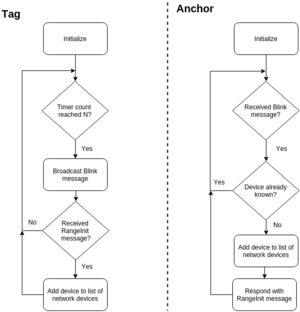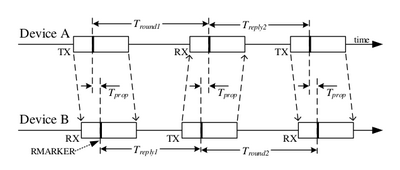3D localization
(→Network topology) |
(→Network topology) |
||
| Line 27: | Line 27: | ||
==Network topology== | ==Network topology== | ||
| − | [[File:Network flow.png| | + | [[File:Network flow.png|300px|thumb|right|Network notification flowchart for anchor and tag]] |
Revision as of 16:58, 29 May 2016
Contents |
Hardware
The localization system at hand consists of at least 4 anchors and a tag.
The hardware design considerations, descriptions and overviews can be found at the Localization Hardware page.
Each device communicates and ranges with each other through an UWB (Ultra-wideband) radio.
Software download
The source code for the system is available here. NB! the software source can not be compiled without the proper tool-chain (see Arm compiler environment for instructions on how to set this up)
A Github repository for the project is available at
TODO: Add github here!
On a Linux computer this can be cloned as:
git clone Something!
Install software tools
In order to modify the software, some tools are required.
- Arm compiler environment and tool-chain - Linux
- Localization Hardware
Network topology
The system is able to automatically register when new devices are joining the network, and as such automatically hand out network addresses to all new devices. This is done by having the tag issue a broadcast message once a second, in order to allow any new non-registered device to answer back, letting the tag know there is an additional device available. The broadcast message is what's called a Blink message, which is actually just a very short message containing no info.
Ranging
In order to estimate the distance between an anchor and a tag, the system uses Time of Flight (TOF). There exists a number of ways to estimate a distance from exchanging packages with timestamps, all with different pros and cons, which has been discussed elaborately in the DW1000 User manual. In this project, it has been chosen to implement and use the double-sided two way ranging scheme as shown in the figure to the right. This method has the advantage that it is the best method for handling any clock skew between the two devices, this means that it will have a smaller impact on the range estimate, if the clock in one device is running slightly faster than the clock of the other device.
The average time of flight between the two devices can be calculated as
From this the distance can be calculated by multiplying the propagation time with the speed of light.
The DS-TWR ranging scheme mentioned above can then be extended through the use of broadcast messages, in order to minimize the required number of data exchanges between devices. One such way could be through the infrastructure based asset tracking scheme as implemented in this project. In this ranging scheme the tag sends a Poll message as a broadcast, which is received by a number of anchors (three in the following case) in the infrastructure. Each anchor then replies in successive responses with packets RespA, RespB & RespC after which the tag, sends the Final message as a broadcast again, received by all three anchors. This allows the tag to be located after sending only 2 messages and receiving 3 (including another 3 if the distances are needed on the tag).
This scheme is illustrated in the figure below. This represents a substantial saving in message traffic, thereby saving battery power and air-time, while increasing potential update rate.
Positioning
The 3d position of the tag can be estimated, through trilateration by using at least four ranges to different anchors.
Talk about different implementations (Nonlinear least squares, particle filter, extended kalman filter)
Sensor fusion
TODO.
Limitations
The system does come with a few limitations, which will be discussed below.
Line of sight (LOS)
The most important limitation is that it is very sensitive to line of sight (LOS). This means that the tag trying to localize itself, should always have pure line of sight to at least 4 anchors, which is why it is recommended to run the system with 6 or more anchors, as this would give the system redundancy. It is possible to get a clue about whether the most recent range measurement was taken in a line of sight situation or not, by looking at the quality of the measurement. This quality is a combination of the received power level and the first path power level, and is discussed further in the DW1000 User manual on page 45.
Calibration
Because the system is based on time of flight measurements of radio waves, even a small change in the time stamps of the system will result in huge variations in distance (1 ns results in a change of 299 mm). This means that proper calibration of the system is crucial in order to obtain any usable performance. The main calibration property of the system is the antenna delay constants, a constant describing the delay from antenna through PCB. A detailed explanation of the antenna delay and how to calibrate it properly can be found in APS014: Antennna Delay Calibration


